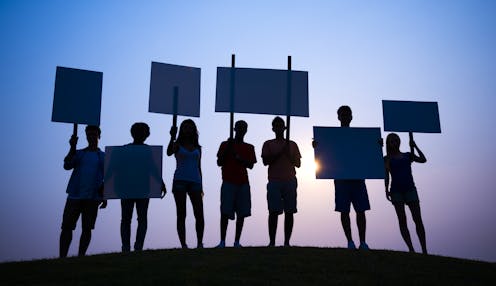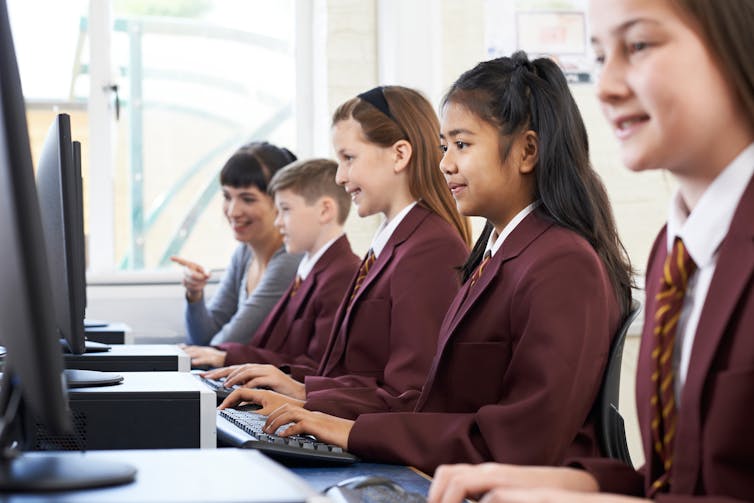
Many people across the UK have been protesting in 2023. Teachers on strike over pay and working conditions marched through London with placards and listened to speeches on March 15. Protests against the government’s illegal migration bill took place in Glasgow, London and Cardiff.
Young people have also been protesting at a number of schools. One issue has been school rules that they claim stops them from going to the toilets during lessons.
Ben Riggott, headteacher at Parkside Community School, where one protest took place, said: “We understand the students were protesting about arrangements for access to toilets while in lessons. Our policy for some time has been that during lesson times students should not leave to use the toilet, unless they have a medical need to use the toilet more often or in an emergency situation.”
Sir John Townsley, chief executive of The GORSE Academies Trust, which runs Farnley Academy in Leeds where a protest took place, said: “Though we do, when necessary, allow children to use toilets during lesson times we strongly encourage our pupils to use the toilets before and after school and during break times.”
Students at a Merseyside school protested against the measurement of girls’ skirts by teachers. “The implementation of the uniform policy was carried about by staff, both male and female,” the school headteacher said.
There are legal limits on the right to protest – and the right to protest is limited by disruption, damage and damage to property. There have been reports that some actions taken by school students did not meet these requirements. This includes reports of students flipping desks, throwing urine, and letting off fire extinguishers.
But it seems that, for some schoolchildren, taking part in any type of protest may risk punishment, even if peaceful and not disruptive. A headteacher at a Northampton school told the Observer that he had informed students that taking part in a protest would lead to suspension or potential permanent exclusion, and that he thought parents’ reference to human rights regarding toilet closures “ludicrous”.
Geoff Barton, general secretary of the Association of School and College Leaders, has said: “Students should raise any concerns they may have through normal and established channels such as student representative bodies or talking to their class teacher. They should not participate in protests and they need to be aware that doing so is very likely to result in disciplinary action.”
Human rights and education
The United Nations committee that monitors children’s rights reminds us that children do not lose their human rights when they walk through the school gates, and should learn their rights from behaviour modelled by the adults teaching them.

The UN Convention on the Rights of the Child can provide useful insight into children’s right to peaceful protest. It recognises children as having legal entitlements, and not solely as being in need of discipline or protection.
There are five rights in the convention on the rights of the child that are particularly relevant. These are the right to non-discrimination (article 2), children’s right to be consulted on matters that affect them (article 12), the right to peaceful assembly (article 15), the right to safety (article 19) and the right to school discipline that is administered in a manner consistent with children’s human dignity (article 28(2)).
Keeping rights in mind
Students have the right to be consulted about decisions on matters that affect them under article 12. If students are asked for their views, a space for nuanced discussion about problems with school policies can be created. It could include consideration of how the outcomes might affect disabled, female or other marginalised students differently.
There are no easy answers, however. Children have the right to peaceful assembly under article 15, but they also have a right to safety under article 19, and schools have an obligation to provide a safe environment for students. Any behaviour by other children that puts this right to safety at risk must, of course, be dealt with appropriately – so long as approaches to doing so are consistent with a child’s dignity.
At one school, for instance, staff met with student representatives to discuss how the toilet policy might be adapted.
These school protests raise questions about how we treat children as part of our society. We can listen to what children say about their experiences. Children’s protests are a form of expression, and all children have a right to have their views heard.
We should consider if how we treat children is likely to cause them embarrassment or discomfort. What’s more, children are expected to learn from adult behaviour. As a society, if we teach children that their rights can be withdrawn or ignored, this may affect how they report abuse or defend the rights of others.
If we wish education to prepare children for responsible life in society, then affording them the human rights of dignity, respect and equality are a good beginning.
Amy Hanna does not work for, consult, own shares in or receive funding from any company or organisation that would benefit from this article, and has disclosed no relevant affiliations beyond their academic appointment.
This article was originally published on The Conversation. Read the original article.







